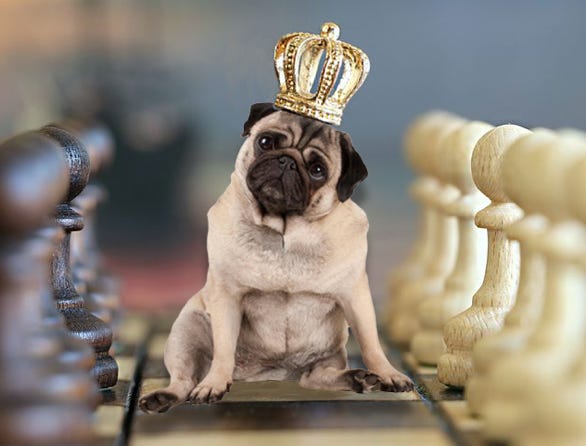UP YOUR DOG SHOW GAME
Helping Breeders &
Exhibitors Succeed in the Show Ring

Damn Good Advice
How Well
Do You Know The Breed?
by
D. McKenna

Nearly forty years ago, I learned a valuable lesson from an older, respected, and successful breeder. At that time, the world of dog shows was shiny, new, and very exciting to me. It was a lesson that I have never forgotten. It was a powerful piece of wisdom and insight that aided and helped shape my thinking and pushed me to improve my knowledge of the breed. I still use this lesson today when evaluating my dogs and the dogs I show for others.
I was in my early twenties then, a first-time Cocker owner and a new member of a large local cocker club in another state. Like many of us, I struggled to understand the terminology used in the breed standard, learn to groom, trim, train, and show my dog. Like many newcomers, I was overconfident in my newfound knowledge. One day, this kind, respected, and long time breeder took me aside and said,
“You don’t really know the breed unless you can find at least ten faults on your dog.”
This doesn’t just mean glaring faults like a sway back or a bad bite. But everything in between, down to the minor fine points that you would improve, such as the tooth size or lack of horny pads on your dog.
It took many years of attending our breed’s National Specialty shows and watching how the top winners moved, were trimmed, and trained. It took many years of sitting ringside, watching the top Sporting, Working, and Herding dog’s movement. It took time and effort to read articles on how structure affects movement. It took time to understand the balance between breed type and sporting movement.
Can you find at least ten faults or areas that need improvement in your dogs? Ask yourself, “How well do I know the breed standard?”
I recently asked several older experience successful breeders, “ What is the best advice you have ever received that impacted your breeding program? Share it with us!” The following are their responses.
From Marcia Joslyn of Gazon Cockers: “Anne Rogers Clark once told me, ‘When choosing puppies in a litter, keep the cute bitch to show, and also her well built sister for breeding.’ Often your best brood bitches are the more common ones. Held true for me. If you can only keep a few dogs. Keep your best bitches. You can breed to any dog/bloodlines in the world. If you want to keep a male in a litter he should be specials quality for your enjoyment or important for your breeding program. Such as old healthy bloodlines or you and have others who want his pedigree. When breeding a litter with your foundation bitch., use your pedigree and a honest critic of your bitch. When breeding to an outcross, breed her to a proven producer of a trait you know your bitch and her lines need. Do the same with line-breeding. Choose the stud dog who is dominant for the good of your lines." Marcia was a very successful breeder and exhibitor who gained an excellent reputation of breeding a line of cockers known for their soundness, movement, and showmanship. Marcia lives in Minnesota and bred over 150 champions from 1981-2016. Marcia’s keen interest in anatomy and movement developed from her degree in Occupational Therapy and her 10 years experience as a girls gymnastics judge. As a new breeder, this lead her to “read everything she could get her hands on” and Al Grossman’s, “Breeding Better Cocker Spaniels” became her bible! In January of 1979, Al gave her an important piece of advice, “Buy the best bitch you can get your hands on, regardless of color.” Marcia also incorporated Al’s advice to “breed to the best line-bred dog with a line of documented traits and health testing.“ The rest is history!
From Barbara Adkins Benson of Wendadam Cockers: “I was told to stay for best in show. Don’t rush off as soon as your own dog has shown rather stay to the end.” You can learn a lot by staying for the entire show. I was also advised to “keep the best puppy from a litter no matter what sex or color.” Another good piece of advice was to “always congratulate the winner and if you’re the winner be gracious.” Also, “know your own dog’s faults and breed to the correct trait.” For instance don’t breed an overshot mouth to an undershot mouth but in either case breed to a correct bite. Barbara and her late husband George, over the span of 25 years, bred or owned 50+ champions, 10 of whom also earned obedience titles. Their proudest accomplishment was their homebred parti-color bitch CH Wendadam’s White Shoulders CD, who produced 15 champions for them. Before George’s passing, he became an AKC judge. Together they have specialed two group-winning Miniature Bull Terriers. and they also campaigned and two Best in Show Boxers. Barbara is currently a CSC of Dallas and an American Spaniel Club member. She has also belonged to all-breed and obedience clubs in their area.
From Carrie Crippen: How do I add my 2 cents? “I was told not to breed to the “Dog of the Day”; but if I really liked him, go to his sire or grand-sire who are proven for the qualities they produce.” Carrie bred her first parti litter in 1990 with a puppy out of that litter eventually beating the number one Parti-color Cocker in the country! She says her “feet didn’t touch the ground for weeks!”
From Shaun and Donna Jordan of Country Squire English Setters:
“The Golden Rules:
1. NEVER double up on a fault.
2. Front assembly and angulation is the easiest to lose and the hardest to get back. Can take many generations to fix.
3. A pretty head is not as easy to lose when breeding and is easy to get back within 1 generation.
4. Don’t breed big to small and expect to get average. You will most likely get big or small. Stick to the standard.
5. Try to breed clear to clear when it comes to health clearances. But don’t throw the baby out with the bath water. A superior specimen could be used with 1 unclear item if the clearances are stellar on the other side. Some exceptions apply. Don’t keep breeding mediocre with all the health clearances or you will keep getting mediocre.
6. Don’t choose a stud dog based on easiness. Choose the best dog for your bitch not the dog in your backyard or don’t do the breeding.
7. Try your best to breed sound to sound. (And good feet too.)”
The Jordans have enjoyed breeding and showing their English Setters for over 35 years. Many have been Best in Show and National specialty winners.
From AKC judge Sid Marx: “There are two pieces of advice that I think have helped me as a judge: The first is not to stand there and stare at them because ‘They are not going to get any better.’ The second was specifically about Irish Setters and it was that ‘when you look at them they should take your breath away and NEVER be common.’ As a young handler, I was taught to ‘show the dog and get out of its way - don't show yourself!’” Mr. Marx says, “I can’t remember when I was without a dog; however, a chance encounter in 1963 with a local judge started me off in the world of the dog show fancy. The first match show ribbon won by my Irish Setter, Lady, hooked me for life!” He credits the time spent as an assistant handler at a sporting dog kennel with furthering his understanding of why a dog has to be built a certain way to do what its breed was meant to do. He was the proud owner-handler of Ch. Bayberry’s Sonnet, a National Specialty BOS winner and one of the top-winning Irish Setter bitches of all time. He was approved as an AKC judge in 1974. He is currently approved to judge BIS, Sporting, Hound, Terrier Groups and several working breeds. He recently was awarded his 50 year judging pin by AKC. He and his wife live happily with their Beagle and an Irish Setter.
From DiAnn Prock of Twilight Cockers: “Best advice I got initially was to “pick a good mentor.” Even though they may give you advice you really don't want to hear, listen to it and learn from it. Do not go searching for answers that you want to hear from someone who may not be as knowledgeable in the breed. Sometimes the truth hurts, but you do learn from it.” DiAnn has been breeding and showing her own dogs since 1995. She has bred over 75 champions, many of which were speciality and group placing dogs.
From Sharon Sherwood: “Know that, if you breed long enough, you will see it all.” Sharon is the owner of the top winning Welsh Springer Spaniel, GCHS CH Rolyart's Navigator @ Painted Sky Farms.
From Eilene White of Crestrail Cockers: Best Advice I received was, “choose what type of cocker you want to breed.” At first I thought the long time breeder was confused...but as I gained experience and knowledge I realized she was spot on. The standard tells us what they should look like but there is room for personal interpretation. Next show go watch for the variety of styles in your chosen breed. Mine is cockers. I chose to go with the sporting type Cocker. Some choose the fancier type with super pretty heads, others go for a more prancing gait. While the sporting type has a longer stride they are not as fun to watch move around the ring because they move effortlessly. They look a bit boring to the fancier type that moves its whole body when it gaits. Both match the standard (neither 100% as there are no perfect dogs).” Eilene has a bachelor Science in breeding and genetics in Equine Science. She has taught at Meredith Manor and Colby Community College in Equine Science. She has used those skills in her cocker breeding and showing program for 25 years, breeding 35 champions to date, all but three were breeder owner handled. Eilene won WD at ASC in 2021 and was WB and BISS Owner Handler at ASC in 2022. She also has numerous wins at specialties shows. Eilene has had the thrill of being asked to give educational lectures at several ASC National shows. She was Editor and Publisher of the Cocker Classic Magazine for 15 years.
A final note from the author: Over the years I have had the privilege of showing some outstanding animals and have done some winning beyond my wildest dreams. All of this was accomplished by years of hard work learning what good Cocker structure and movement is, and learning to train and groom like the pros. All of this was accomplished without the aid of a professional handler or a photoshopped advertising champaign. But it wasn’t always that way. I started at the bottom with mediocre dogs. I lost a lot. But I was determined to never stop learning, always ask questions, read articles written by those who succeeded, and go to years of handling and training classes. Through all of this I learned a great life lesson: hard work pays off! Deborah started breeding and showing Parti Cocker Spaniels in 1981, during the “hay-day” of Cocker Spaniels. Today she is no longer breeds, but enjoys helping new breeders and exhibitors and continues to handle occasionally for Mardi Gras Cockers.
A special thank you to all those who shared their “Damn Good Advice!”

“Read everything
you can
get your
hands on.”